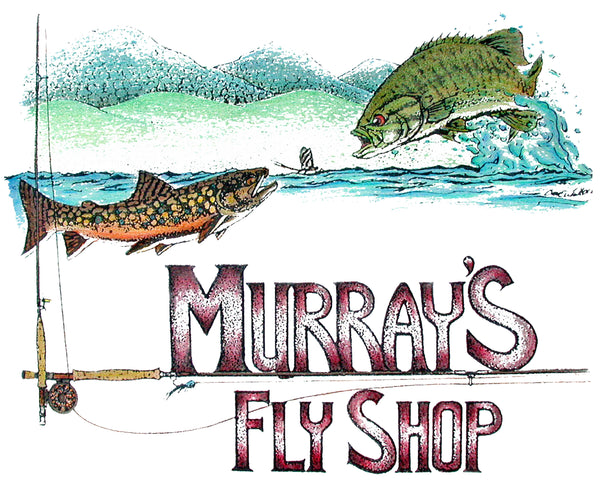How to Fish and Tie the Murray's Hellgrammite

An example of the natural hellgrammites found on the rivers.
The smallmouth bass in many rivers consume more natural hellgrammites than any other single food form! The reason for this is quite simple; there are more hellgrammites in many rivers than any other natural food.
As a youngster growing up on the North Fork of the Shenandoah River in Edinburg, Virginia the hellgrammite was my favorite bait to use when smallmouth fishing. A few minutes of seining with an old window screen would enable me to catch enough of this larva of the dobsonfly to fish with all day. Not only did I catch good numbers of smallmouths on the hellgrammites, but I caught many large bass on them.---The respect I had for this natural bait was well earned.
After returning to the Shenandoah Valley from college I became quite serious about fly fishing and fly tying. It was only natural to try to purchase the best hellgrammite fly patterns to use for my smallmouths.
Those I purchased from Abercrombie and Fitch in New York in the early sixties really impressed me when I dumped them from their neat little green shipping box onto the prescription counter in my drug store. They were truly masterful examples of the fly tyers art; they looked so much like real hellgrammites to me that I almost expected them to crawl off the counter.
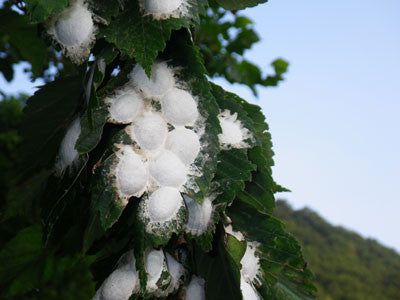
When you float the Shenandoah River in late summer you will see many Dobsonfly Eggs which look like white splats of paint hanging on the tree leaves.
Unfortunately the bass lacked my enthusiasm because I caught only a few fish on them and these were dinks.
About this time I started fishing the large Montana rivers for trout and one of my guides showed me several good giant stonefly nymph patterns. With a few minor alterations I thought this could be the answer to my search for an effective hellgrammite pattern for my smallmouths back in Virginia so I had a fly tyer in Montana tie up several dozen in much larger sizes.---I was wrong, these were even less productive than the ones I had purchased from Abercrombie and Fitch.
My first thoughts were that possibly I was simply not a good enough nymph angler to catch the bass on these flies, and that the blame was therefore on me and not the flies. I continued using the techniques which Charlie Brooks taught me in the Rockies since he was the best nymph fisherman I knew there. I also used what Jack Sperry taught me here in Virginia for I felt he was the sharpest smallmouth fly fisherman in the east.
Still, my results with every Hellgrammite pattern I could find were very disappointing.
Finally, in frustration, I decided to watch how the real hellgrammites behaved in the stream in order to determine just what all those bass of my youth were turned on to. I collected a number of real hellgrammites from a riffle and dropped them one by one into the river at various spots, in a variety of currents where I could closely watch their behavior.
Instantly I saw there was a great difference in the action of the real hellgrammites and the action of my patterns in the stream. Most of the real hellgrammites swam downstream with a very pronounced undulating motion as they angled for the stream bottom. This showed the bass a lively action from a very much alive real hellgrammite. My nymphs, on the other hand, showed them a rigid surfboard-like posture with no natural movement which apparently had little or no appeal for them.
With the realization for the need of a more realistic acting hellgrammite several of us tied many patterns with a variety of materials over the next several years and fished them all as skillfully as we could. However, even our beautiful three-jointed wiggle nymphs let us down.
Finally the skillful Pennsylvania fly tyer Ron Kommer hit upon using ostrich herl for the wings and tails on his giant musky streamers. Right away we jumped on this as the extended body of or hellgrammites, for unlike marabou which collapses back over the hook when fished upstream if the current is moving faster than the fly, the strong fibers of the ostrich herl adhere together when wet. When fished upstream this extended body undulated in the current very much like the real hellgrammite did. It was a simple matter to Palmer the fly in such a way to produce the compulsory “in-the-round” look which Charlie Brooks felt was a must on all nymphs and to add the rubber pincers which Jack Sperry said he “had to have on all underwater bass flies.”
Thus the Murray’s Hellgrammite evolved from frustration, observation, experimentation and a generous dose of luck. However, we were glad to get it because for the past twenty years it has been one of our most productive smallmouth flies.---It is also one of our best flies for big brown trout in large western rivers but that is a fringe benefit.
Fishing the Murray’s Hellgrammite
The natural habitat for the hellgrammites are beneath cobblestones on the bottom of the river, and their greatest concentrations are in the riffles and the well aerated runs below the riffles.An exceptionally effective tactic and the method most anglers in my schools use to catch their largest bass is to fish this area by casting the Hellgrammite across stream below these riffles and crawl the fly slowly across the stream bottom. By gradually working your way across the stream or downstream, depending on the depth of the water, it is possible to show your Hellgrammite to every fish in front of you.
The advantage of this across and downstream tactic is that you can easily feel the strikes of the fish and can thus easily hook a high percentage of the strikes. The disadvantage is that unless you go to a fast sinking tip line you may not be able to get your nymph as deep as you would like it. If this is the case you can go to the upstream dead drifting tactic.
The mechanics are entirely different, for with the upstream dead drifting tactic you are wading upstream, casting upstream and detecting your strikes by seeing them on your indicator system.
The secret for success with this technique rest upon being able to instantly detect the fish’s strike when he picks up the nymph because in about one second he knows he’s made a mistake and ejects the fly. This instant strike detection is possible only if you keep a tight line from the nymph to the line hand throughout the drift. Remember, you must “see” the strike.
Here is how I teach this method in my schools. 1. On the presentation cast do not allow the line to drop from the line hand, 2. Keep the line hand within six inches of the rod hand on the cast. 3. While the line is turning over in the air on the presentation cast place the line over the first or second finger of the rod hand and strip in all the slack line so you have a tight line to the nymph when it lands on the water. 4. Use long, smooth strips with your line hand to retrieve the line at the same rate the current is pushing the Hellgrammite back downstream. 5. Watch the Scientific Anglers Indicator on your leader very closely and instantly set the hook when you see the strike.
This is the whole upstream game and there are no gremlins hiding in the stream to hamper your success as some anglers believe. You simply wade upstream from pocket to pocket and run to run and drift your Hellgrammite through each deep spot and watch closely for the take.
The final tactic I use with the Murray’s Hellgrammite is my “swing nymphing tactic”. I go to this method when there is water too deep or too heavy to wade out beside me in the river and the down and across tactic is not getting my flies down to the bottom. This technique is unlike the previous two methods but it draws from the best features of both. It is actually quite similar to a technique Charlie Brooks taught me long ago to use in the deep runs in the Madison River in Montana for brown trout.
In “swing nymphing” I’m wading downstream, casting up and across stream to fish the water right beside me and I’m trying to feel the strike.
Here’s how it goes.---Carefully set yourself up from ten to twenty feet straight to the side of the good looking water. Cast up and across stream at about forty-five degrees so the nymph falls about ten feet upstream of where you expect the fish to be holding. Do not strip in any line initially, rather allow time for the nymph to sink to the stream bottom. Once you have good depth extend your fly rod up and out over the drifting line and strip in the slack with the line hand. Swing the rod downstream at the same rate the nymph is drifting, being sure to maintain a tight line on the Hellgrammite so you can feel the strike. Make the next cast about five feet further out and five feet further upstream and repeat the swinging technique. Continue this until you’ve covered all of the good looking water then wade downstream about ten feet and repeat the pattern.
The “swing nymphing tactic” is very easy to learn. In fact, I have many beginning anglers master it so well that by the end of the day of my Smallmouth Bass Schools they are catching the largest bass this way. Once you perfect this method it will enable you to run your flies deeper than any method you can use with a floating line.
Now that you see why we felt we needed a better hellgrammite and the tactics for fishing it let’s look at how easy it is to tie. If you are just getting into Fly Tying then consider taking one of our Fly Tying Workshops.
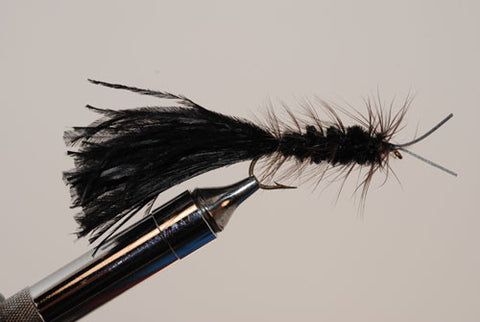
The original Murray's Hellgrammite, shown here, later inspired the Murray's Heavy Hellgrammite with weighted eyes for greater depth.
How to Tie the Murray's Hellgrammite
Components: Hook: 3X long medium heavy, sizes 4-12 Thread: Black 3/0 prewaxed monocord Body: Black chenille, medium or large per hook size Hackle: Soft domestic rooster black saddle hackle Pincers: Medium black rubber Weight: Size small lead free barbell eyes or lead free wire to match diameter of hook wire Fly Tying Tip: Tying the Murray's Hellgrammite Bass Fly - Murray's Fly Shop from Murray's Fly Shop on Vimeo. Tying Steps:- Place the hook in the vise. Cover the hook shank with thread and coat it with cement. Choose strong ostrich herl for the extended rear body and break off the weak tips between your thumb nail and your index finger. (About twenty is correct for a size 6 hook.) Tie the ostrich herl over the bend of the hook so the tips extend to the rear about twice the length of the hook shank.
- Tie in the lead free eyes about one-fourth of an inch behind the hook eye.
- Tie the hackle in by the tip over the bend of the hook. Tie the chenille in over the bend of the hook. Advance the thread to the hook eye.
- Tie in the rubber pincers about one-eighth of an inch behind the eye so they spread to the right and left of the hook shank at about a ninety degree angle to each other. Figure eight the thread over the pincers to lock them in place.
- Wind the chenille forward to hook eye and tie off and cut off.
- Palmer the hackle forward in five or six neatly spaced wraps and tie off in front of the chenille. Trim off extra chenille. Whip finish. Coat knot with cement.
-
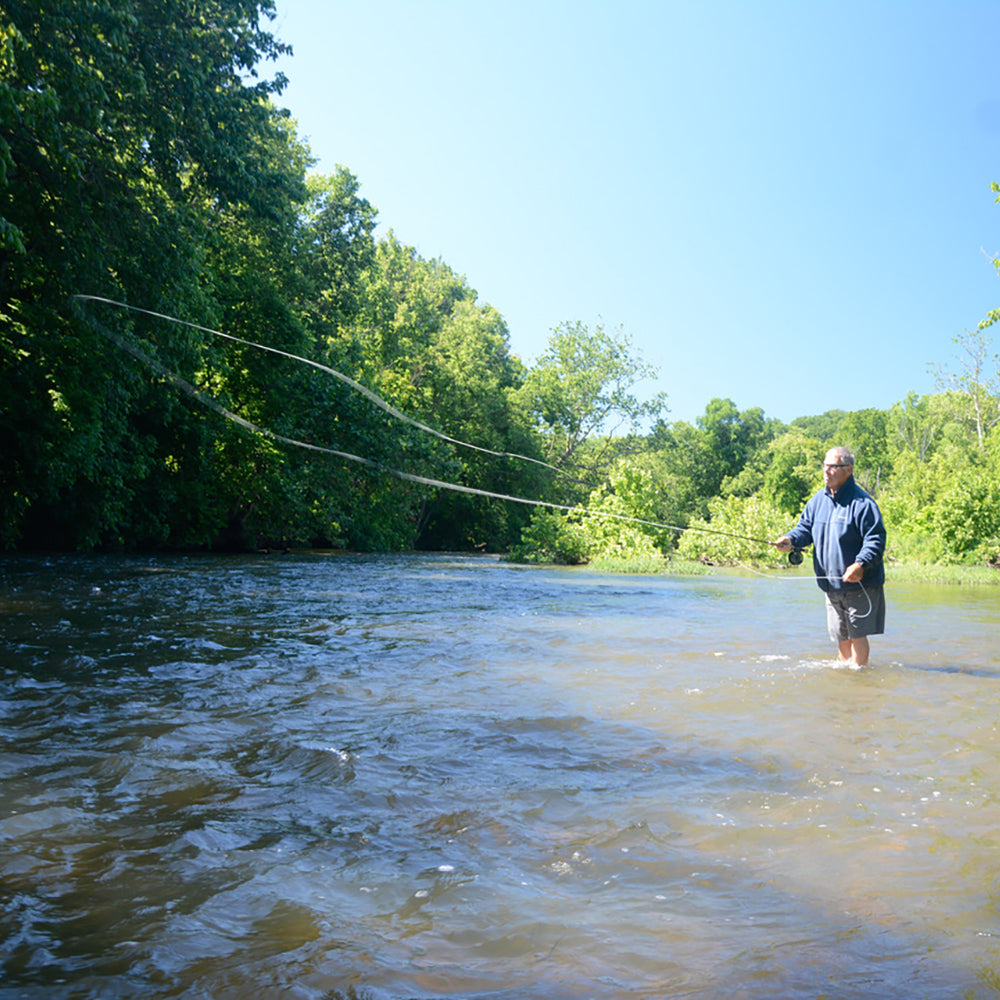
Learn Fly Fishing at Murray’s Fly Shop: Classes, Workshops & Schools
Welcome to Murray’s Fly Shop – Your Fly Fishing Learning Hub At...
-

Featured Flies of the Month
Harry Murray's recommended fly list for this time of the year. (March...
-
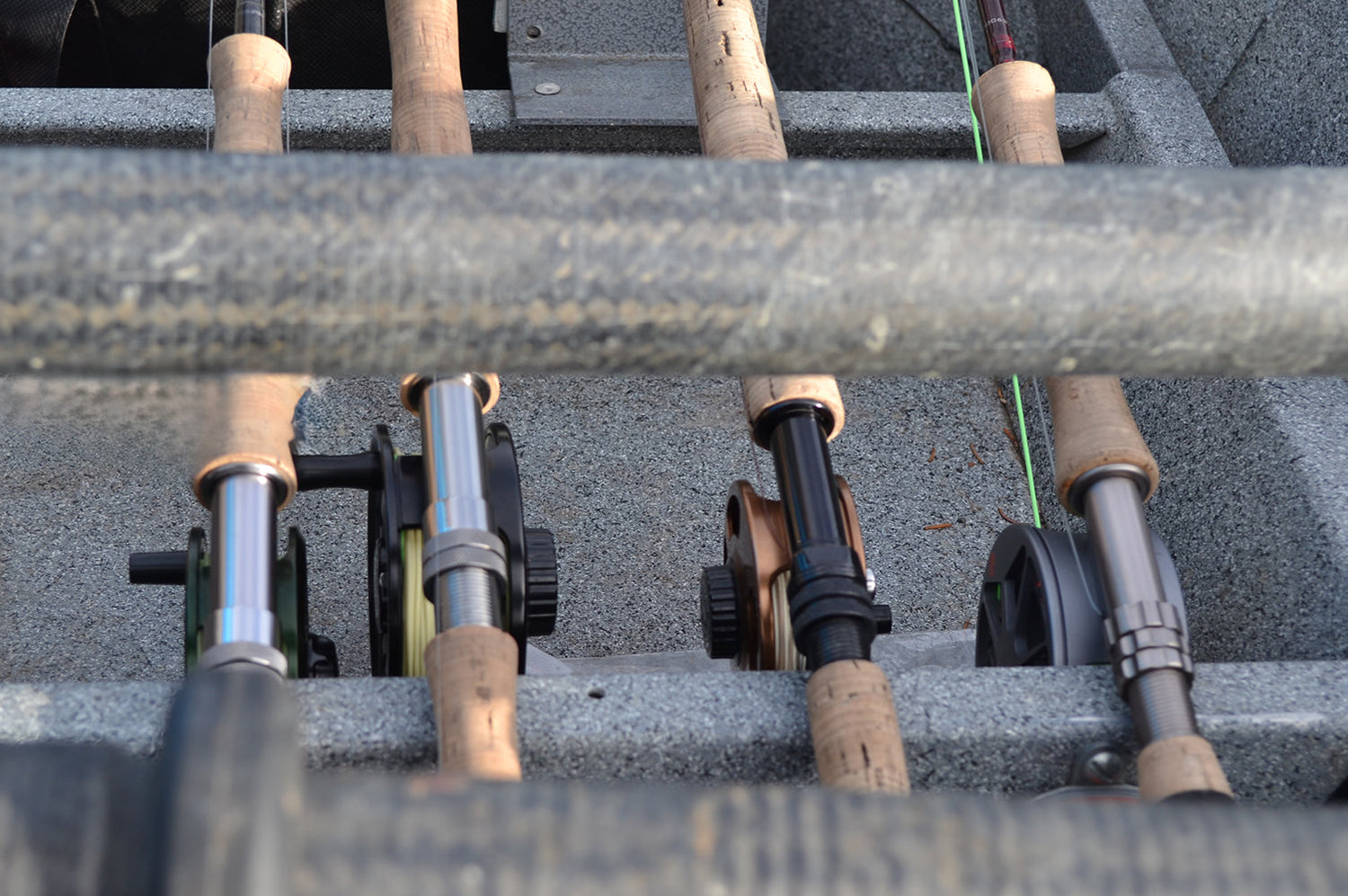
Fly Fishing Rod Outfits
Fly Fishing Rod and Reel Outfits for Smallmouth Bass fly fishing, Trout...
